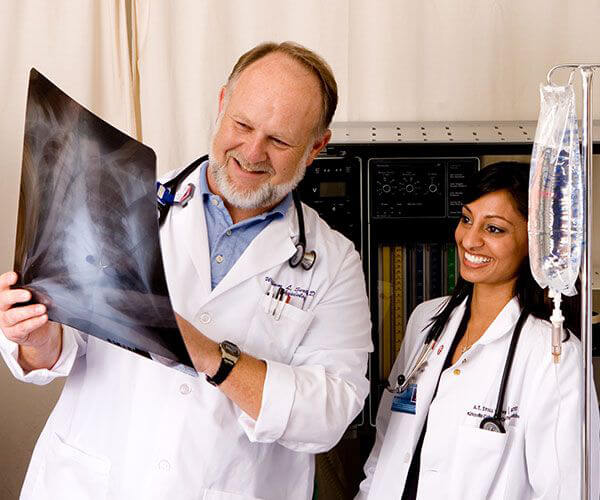Program learning outcomes
Program Learning Outcomes (Professional Competencies)
Graduates from the ATSU Central Coast Physician Assistant Program (CCPAP) will achieve a specific set of competencies during their course of PA study. These core competencies for new PA graduates were developed by the Primary Care Competencies Task Force of the Physician Assistant Education Association to represent the skills, attributes, and behaviors expected of any new PA graduate.
The goals and learning outcomes provided for CCPAP courses are designed to prepare the learner in a manner that they will be able to excel in the following professional competencies:
1. Patient-centered practice knowledge
1.1 Recognize normal and abnormal health states
1.2 Discern among acute, chronic, and emerging disease states
1.3 Elicit and understand the stories of individual patients and apply the context of their lives (including environmental influences, cultural norms, socioeconomic factors, and beliefs) when determining healthy versus ill patients
1.4 Develop meaningful, therapeutic relationships with patients and their families (PA Comp. PC, FMM)
1.5 Partner with patients to address issues of ongoing signs, symptoms, or health concerns that remain over time without clear diagnosis despite evaluation and treatment (PA Comp. PC)
2. Society and population health
2.1 Recognize the cultural norms, needs, influences, and socioeconomic, environmental, and other population-level determinants affecting the health of the individual and community being served
2.2 Recognize the potential impacts of the community, biology, and genetics on patients and incorporate them into decisions of care
2.3 Demonstrate accountability and responsibility for removing barriers to health
2.4 Understand the role of structural disparities in causing illness
2.7 Reflect on personal and professional limitations in providing care
2.8 Exercise cultural humility
2.9 Elicit and hear the story of the individual and apply the context of the individual’s life (including environmental influences, culture, and disease) when determining healthy versus ill patients
2.10 Understand and apply the fundamental principles of epidemiology
2.11 Recognize the value of the work of monitoring and reporting for quality improvement
2.12 Use appropriate literature to make evidence-based decisions on patient care
3. Health literacy and communication
3.1 Establish meaningful, therapeutic relationships with patients and families that allow for a deeper connection and create space for exploration of the patients’ needs and goals to deliver culturally competent care (PA Comp. PC, FMM)
3.2 Interpret information so that patients can understand and make meaning out of the information conveyed to them
3.3 Recognize the need for and governing mandates that ensure patients have access to interpreters and appropriate resources when barriers to communication arise
3.4 Demonstrate insight and understanding about emotions and human responses to emotions that allow one to develop and manage interpersonal interactions (PCRS 4.7)
3.5 Communicate effectively with patients, families, and the public
3.6 Provide effective, equitable, understandable, and respectful quality care and services that are responsive to diverse cultural health beliefs and practices, preferred languages, health literacy, and other communication needs (CLAS)
3.7 Organize and communicate information with patients, families, community members, and health team members in a form that is understandable, avoiding discipline-specific terminology when possible, and checking to ensure understanding (IPEC CC2)
4. Interprofessional collaborative practice and leadership
4.1 Articulate one’s role and responsibilities to patients, families,communities, and other professionals (IPEC RR1)
4.2 Redirect the focus of the health care team to the needs of the patient
4.3 Assure patients that they are being heard
4.4 Ensure patients’ needs are the focus over self and others
4.5 Contribute to the creation, dissemination, application, and translation of new health care knowledge and practices (PCRS 2.6)
4.6 Recognize when referrals are needed and make them to the appropriate health care provider
4.7 Coordinate care
4.8 Develop relationships and effectively communicate with physicians, other health professionals, and health care teams (PA Comp. Comm)
4.9 Use the full scope of knowledge, skills, and abilities of available health professionals to provide care that is safe, timely, efficient, effective, and equitable (IPEC RR5)
5. Professional and legal aspects of health care
5.1 Articulate standard of care practice
5.2 Admit mistakes and errors
5.3 Participate in difficult conversations with patients and colleagues
5.4 Recognize one’s limits and establish healthy boundaries to support healthy partnerships
5.5 Demonstrate respect for the dignity and privacy of patients while maintaining confidentiality in the delivery of team-based care (IPEC VE2)
5.6 Demonstrate responsiveness to patient needs that supersedes selfinterest (PCRS 5.2)
5.7 Demonstrate accountability to patients, society, and the profession (PCRS 5.4)
5.8 Exhibit an understanding of the regulatory environment
6. Health care finance and systems
6.1 Recognize that health care is a business
6.3 Appreciate the value of the collaborative physician/PA relationship
7. Essential skills
“Comp_Skill_01- Accountability”
“Comp_Skill_02- Active community engagement”
“Comp_Skill_03- Active listening”
“Comp_Skill_04- Adaptability”
“Comp_Skill_05- Advocacy”
“Comp_Skill_06- Awareness of biases and attitudes towards others”
“Comp_Skill_07- Care coordination”
“Comp_Skill_08- Care planning”
“Comp_Skill_09- Coding”
“Comp_Skill_10- Cultural competency”
“Comp_Skill_11- Discernment of important versus extraneous information”
“Comp_Skill_12- Effective communication”
“Comp_Skill_13- Empathetic listening”
“Comp_Skill_14- Ethical decision-making”
“Comp_Skill_15- Evidence-based decision-making”
“Comp_Skill_16- Health literacy”
“Comp_Skill_17- Help-seeking behaviors”
“Comp_Skill_18- History-taking”
“Comp_Skill_19- Humanism”
“Comp_Skill_20- Information gathering”
“Comp_Skill_21- Integrity”
“Comp_Skill_22- Interpersonal skills including beneficence, compassion, influence, empathy, and humility”
“Comp_Skill_23- Knowing when to consult”
“Comp_Skill_24- Leadership”
“Comp_Skill_25- Patient advocacy”
“Comp_Skill_26- Patient agency”
“Comp_Skill_27- Patient and personal safety”
“Comp_Skill_28- Patient education”
“Comp_Skill_29- Physical examination”
“Comp_Skill_30- Practice-based improvement”
“Comp_Skill_31- Prioritization of actions and clinical care decisions based on information available and the patient’s beliefs about their care”
“Comp_Skill_32- Quality improvement”
“Comp_Skill_33- Reimbursement”
“Comp_Skill_34- Relationship development”
“Comp_Skill_35- Resourcefulness”
“Comp_Skill_36- Responsibility”
“Comp_Skill_37- Self-advocacy (skills, interests, and needs)”
“Comp_Skill_38- Self-agency (priority, exclusivity, and consistency)”
“Comp_Skill_39- Self-awareness”
“Comp_Skill_40- Teamwork”
“Comp_Skill_41- Technology fluency”
“Comp_Skill_42- Trust-building”

